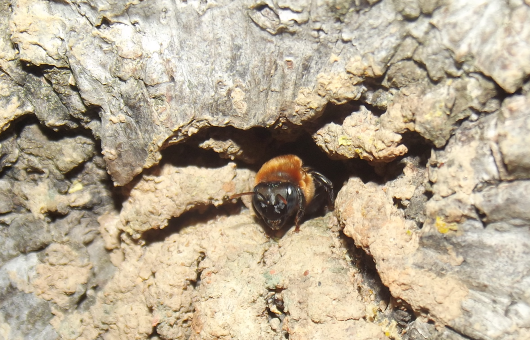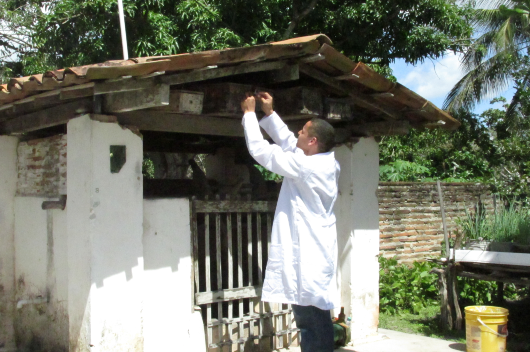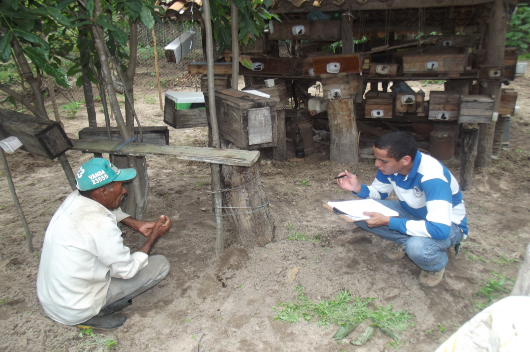
Ceara's first comprehensive survey of stingless bees finds 20 new species for the state
Responsible for playing an essential role in balancing ecosystems, through pollination, and for generating income for rural families through an important production chain, the stingless bees are, now, mapped in Ceará. The first comprehensive survey of this insect ever carried out in Ceará territory revealed the presence of 20 species new to the state, totaling now 49 species. The cataloged information proves a diversity that can expand business opportunities, contribute to the conservation of bees and guide a more sustainable development.
The survey was prepared by researchers from the Federal University of Ceará. Started still in 2013 with the doctoral thesis in Animal Science by Jânio Angelo Felix, under the guidance of Prof.. Breno M. Freitas, the study involved collecting bee samples in 122 localities, reaching 52 municipalities in Ceará and covering all regions of the State. After this phase, scientific identification of each species was carried out., the most time-consuming step of the process. The results have just been published inAnnals of the Brazilian Academy of Sciences (AABC).
the stingless bees, also called meliponis, are present in various regions of the state and are used mainly for the production of honey, through the activity known as meliponiculture. The study shows that this production is based especially on the creation of the jandaíra, a species that evolved in the caatinga and adapted well to the conditions of this vegetation, which accounts for 80% from Ceará territory. The pushing, Yet, exposes information that can be used for the redesign of that production chain.

"As the population comes to know and value the products of other bees, diversification will be a natural consequence”, defends Janio Felix. According to him, local producers prefer jandaíra as it is a species that produces more honey, the most sought after product by the consumer. Mandaçaia and Uruçu species, that are part of the same genus as the jandaíra, have this same characteristic and are also created here, although on a much smaller scale. But, says researcher, there are several opportunities to expand the range of products through the implementation of other species in the meliponiculture of the state.
“The jataí (of the genus Tetragonisca) is highly valued for its honey in other states of Brazil. Besides, the sanharó and bunda-de-vaca species (of the genus trigona) and straw and tubiba (Scaptotrigona spp.) are excellent pollen producers, normally unexplored product. the bees pitch, black girl and white girl (Frieseomelitta spp.) produce a lot of resin, while other groups are good geopropolis producers", informs Felix.
In addition to these products, the use of stingless bees in economic activities can be done through agricultural pollination, which consists of using or renting colonies for this purpose, or also through ecological tourism. Environmental education is another area with potential for the use of meliponis. "All of these are direct or indirect products that can be rationally and sustainably explored", reinforces the researcher.
NEW SPECIES
The specialized literature so far recorded the occurrence of 29 species of stingless bees in Ceará. According to Janio Felix, it was expected to find a greater number of species, as a survey with the scope of the current. However, to discover 20 more species was a surprise, admits.
It is important to clarify that these species are only new to the territory of Ceará., so, they were already found in other locations. in addition to 49 reported in the state, there are three others that have not yet been validated as distinct species., what can make the number of species in Ceará reach 52.
The data produced by the study are already present in theFauna inventory: Ceará invertebrates, released in early August, and in the UFC's bee collection. The researchers say they intend to continue monitoring the state's bee diversity, adding any new occurrences to these lists.
POPULATION DECLINE

Despite presenting an even greater richness of the bee fauna than previously known, the research reports that there is a decline in populations of these insects in Ceará, just like all over the world. some species, like the glass eye and the mandaçaia, previously observed in abundance in the state, are now at imminent risk of extinction, according to the study. Besides, the survey showed that the uruçu- northeastern possibly no longer exists in natural conditions in Ceará.
The reasons for the problem with the most diverse species of bees, all around the world, are diverse and include climate change, diseases, invasive species, pesticide misuse, deforestation and increased urbanization. In the case of meliponineos in Ceará, a Prof. Breno Freitas points out the high degree of devastation of native vegetation throughout the state and the predation of honey trees (people who destroy nests in search of honey) as the main causes. The misuse of pesticides and climate change are identified as the most recent threats.
Studies that show the occurrence and diversity of bee species can serve as a basis for the conservation not only of these insects but of the entire environment, since they are among the main responsible for the pollination of native and cultivated flora.
"We need to know, know of existence, to conserve", argues Prof.. Breno Freitas. "Our motivation with the study was to survey how many species we have, how are distributed in the state, investigate the relationship of the occurrence with plant formations, ultimately, generate information that could contribute so much to rational development, diversified and sustainable meliponiculture in Ceará as well as for the conservation of different species", justified.

One of the problems still existing in meliponiculture is the improper transport of species between different regions, action that, inclusive, is prohibited by federal law through Resolution of 2004 of the National Council for the Environment (CONAMA). According to the teacher, many producers, especially newcomers to the field, do not know the consequences of this transport. Bees raised in the diverse environment they naturally inhabit can have adaptation problems and compete for space and resources with native species.. Besides, can transmit diseases to local bees, even causing its extinction.
The survey provides information necessary to mitigate this disorder, because it shows which types of bees are adapted to each climate and vegetation condition. The distribution of stingless bees, show the document, does not happen homogeneously in Ceará, being strongly linked to the specific conditions of each environment. Most of the diversity of bees, for example, was found in the rainforests of the state, located in the mountains, which registered 19 different species. in the caatinga, despite representing a much larger territory, were found only 7 species.
"It is important to highlight that the stingless bees' greatest friend has been the beekeeper, and if sometimes he acts differently than ideal, it is usually for lack of knowledge and not bad faith", emphasizes Prof.. Breno Freitas. According to him, these professionals generally adopt new knowledge "almost immediately when they have access to it". These form, believe, the survey carried out may contribute to the better development of the activity in the state.
Sources: Prof. Breno Freitas, from the Department of Animal Science – e-mail: freitas@ufc.br; Janio Felix – email: janiozootecnia@yahoo.com.br
Text extracted from: https://agencia.ufc.br/primeiro-levantamento-abrangente-de-abelhas-sem-ferrao-do-ceara-encontra-20-novas-especies-para-o-estado/#new_tab

Sorry, the comment form is closed at this time.